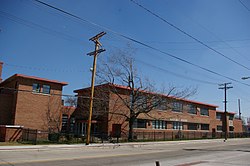
Wallace Henry Thurman was an American novelist and screenwriter active during the Harlem Renaissance. He also wrote essays, worked as an editor, and was a publisher of short-lived newspapers and literary journals. He is best known for his novel The Blacker the Berry: A Novel of Negro Life (1929), which explores discrimination within the black community based on skin color, with lighter skin being more highly valued.
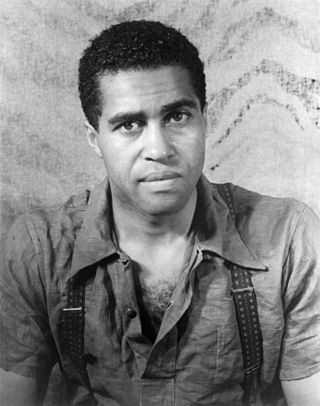
Robert Earl Jones, sometimes credited as Earl Jones, was an American actor and professional boxer. One of the first prominent black film stars, Jones was a living link with the Harlem Renaissance of the 1920s and 1930s, having worked with Langston Hughes early in his career.

Rose McClendon was a leading African-American Broadway actress of the 1920s. A founder of the Negro People's Theatre, she guided the creation of the Federal Theatre Project's African American theatre units nationwide and briefly co-directed the New York Negro Theater Unit.

Shuffle Along is a musical composed by Eubie Blake, with lyrics by Noble Sissle and a book written by the comedy duo Flournoy Miller and Aubrey Lyles. One of the most notable all-Black hit Broadway shows, it was a landmark in African-American musical theater, credited with inspiring the Harlem Renaissance of the 1920s and '30s.
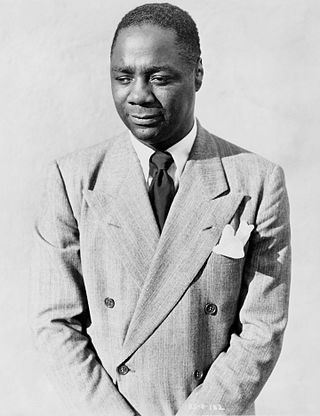
Canada Lee was an American professional boxer and then an actor who pioneered roles for African Americans. After careers as a jockey, boxer and musician, he became an actor in the Federal Theatre Project, including the 1936 production of Macbeth adapted and directed by Orson Welles. Lee later starred in Welles's original Broadway production of Native Son (1941). A champion of civil rights in the 1930s and 1940s, Lee was blacklisted and died shortly before he was scheduled to appear before the House Un-American Activities Committee. He advanced the African American tradition in theatre pioneered by such actors as Paul Robeson. Lee was the father of actor Carl Lee.

The American Negro Theatre (ANT) was co-founded on June 5, 1940 by playwright Abram Hill and actor Frederick O'Neal. Determined to build a "people's theatre", they were inspired by the Federal Theatre Project's Negro Unit in Harlem and by W. E. B. Du Bois' "four fundamental principles" of Black drama: that it should be by, about, for, and near African Americans.

Juanita Hall was an American musical theatre and film actress. She is remembered for her roles in the original stage and screen versions of the Rodgers and Hammerstein musicals South Pacific as Bloody Mary – a role that garnered her the Tony Award – and Flower Drum Song as Madame Liang.
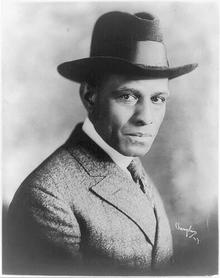
Charles Sidney Gilpin was one of the most highly regarded stage actors of the 1920s. He played in critical debuts in New York City: the 1919 premier of John Drinkwater's Abraham Lincoln and the lead role of Brutus Jones in the 1920 premiere of Eugene O'Neill's The Emperor Jones, also touring with the play. In 1920, he was the first black American to receive The Drama League's annual award as one of the 10 people who had done the most that year for American theatre.

The Harlem Renaissance was an intellectual and cultural revival of African American music, dance, art, fashion, literature, theater, politics and scholarship centered in Harlem, Manhattan, New York City, spanning the 1920s and 1930s. At the time, it was known as the "New Negro Movement", named after The New Negro, a 1925 anthology edited by Alain Locke. The movement also included the new African American cultural expressions across the urban areas in the Northeast and Midwest United States affected by a renewed militancy in the general struggle for civil rights, combined with the Great Migration of African American workers fleeing the racist conditions of the Jim Crow Deep South, as Harlem was the final destination of the largest number of those who migrated north.

William Francisco Cobbs is an American actor. He is known for such film roles as Louisiana Slim in The Hitter (1979), Walter in The Brother from Another Planet (1984), Reginald in Night at the Museum (2006) and Master Tinker on Oz the Great and Powerful (2013). He played Lewis Coleman on I'll Fly Away (1991–1993), Jack on The Michael Richards Show (2000), and had guest appearances on Walker, Texas Ranger and The Sopranos. In 2020, he won a Daytime Emmy Award for Outstanding Limited Performance in a Daytime Program for the series Dino Dana.

Mule Bone: A Comedy of Negro Life is a 1930 play by American authors Langston Hughes and Zora Neale Hurston. The process of writing the play led Hughes and Hurston, who had been close friends, to sever their relationship. Mule Bone was not staged until 1991, when it was produced in New York City by the Lincoln Center Theater.
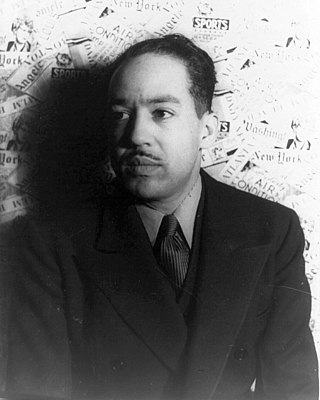
James Mercer Langston Hughes was an American poet, social activist, novelist, playwright, and columnist from Joplin, Missouri. One of the earliest innovators of the literary art form called jazz poetry, Hughes is best known as a leader of the Harlem Renaissance. He famously wrote about the period that "the Negro was in vogue", which was later paraphrased as "when Harlem was in vogue."

"The Negro Speaks of Rivers" is a poem by American writer Langston Hughes. Hughes wrote the poem when he was 17 and crossing the Mississippi River on the way to visit his father in Mexico. It was first published the following year in The Crisis, starting Hughes's literary career. "The Negro Speaks of Rivers" uses rivers as a metaphor for Hughes's life and the broader African-American experience. It has been reprinted often and is considered one of Hughes's most famous and signature works.

Fairfax is a neighborhood on the East Side of Cleveland, Ohio. It is roughly bounded between Euclid Avenue to the north, Woodland Avenue to the south, E. 71st Street to the west and E. 105th Street to the east. Fairfax is located on the edge of University Circle, an area containing Cleveland's major educational institutions and museums. The Karamu House is on the National Register of Historic places and is the nation's oldest African-American theater. The northeastern quadrant of Fairfax, along Euclid Avenue to 105th Street, is dominated by the Cleveland Clinic.
Lewis Grandison Alexander was an African American poet, actor, playwright, and costume designer who lived in Washington, D.C., and had strong ties to the Harlem Renaissance period in New York. Alexander focused most of his time and creativity on poetry, and it is for this that he is best known.
A number of theatre companies are associated with the Harlem Renaissance.
Leonard Rudy Parker Jr. was an American actor in theater, film and television. He is known for his performance in the film Nothing But a Man.
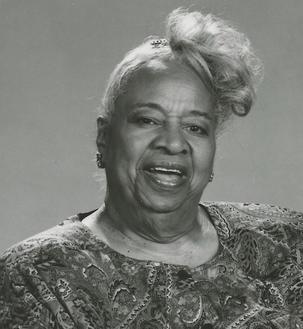
Frances Elizabeth Williams was an American actress, activist, theatre producer, organizer, and community worker. Williams was the first black woman to run for the California State Assembly in 1948 on the Progressive Ticket and served on the boards of the Screen Actors Guild, Actors' Lab, and Actors Equity. She represented the World Peace Council at the first Angola Independence Celebration in 1975, and co-founded the Art Against Apartheid Movement in Los Angeles in the 1980s.
William "Skinny" Elijah Smith (1913–1997) was an African American artist who was recognized for exploring Black experiences in his art. Friend and poet Langston Hughes once described Smith's work as the "humor and pathos of Negro life captured in line and color."

Dale Ricardo Shields is an African American actor, director, producer, and educator. He is one of ten teachers nationwide who received the 2017 The Kennedy Center/Stephen Sondheim Inspirational Teacher Award.
